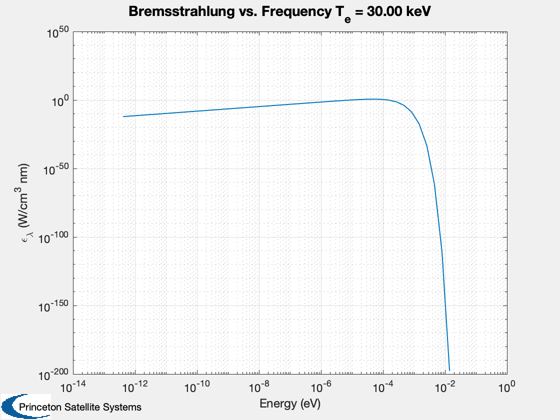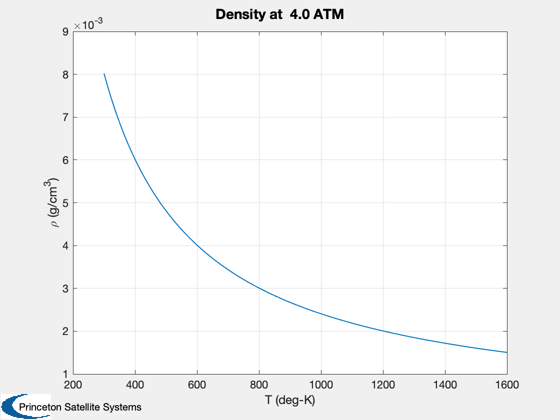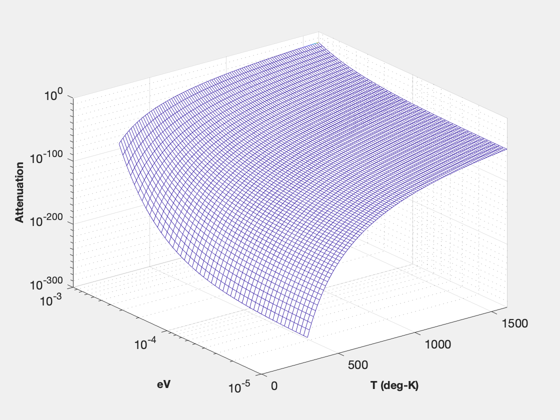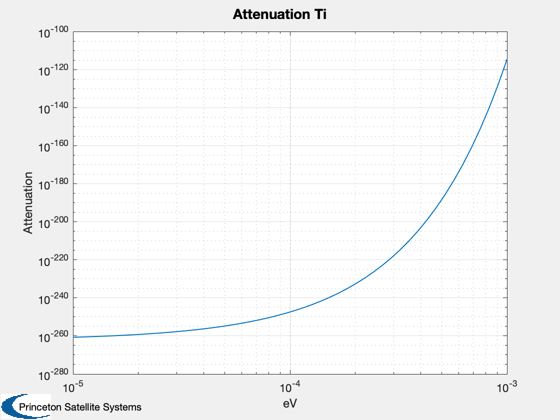Demonstrate x-ray attenuation
X-rays are from bremsstrahulung. Requires RFromCPAndGamma.
%-------------------------------------------------------------------------- % See also: XRayMassAttenCoeff, BremsstrahlungFrequency, PhotonEnergy, % RFromCPAndGamma %-------------------------------------------------------------------------- %-------------------------------------------------------------------------- % Copyright (c) 2018 Princeton Satellite Systems, Inc. % All rights reserved. %-------------------------------------------------------------------------- % Since 2018.1 %-------------------------------------------------------------------------- nI = [1e14 1e14]; zI = [1 2]; tE = 30000; nu = logspace(2,14); b = BremsstrahlungFrequency( nu, tE, nI, zI ); e = PhotonEnergy(nu); yL = {'\epsilon_\lambda (W/cm^3 nm)' }; s = sprintf('Bremsstrahlung vs. Frequency T_e = %5.2f keV',tE/1000); Plot2D(e,b,'Energy (eV)',yL,s,'log') % Gas t = linspace(300,1600); cP = 424; thick = 4; % cm gamma = 1.659; r = RFromCPAndGamma( cP, gamma ); pAtm = 4; p = pAtm*101325; rho = (p./(r*t))*1e-3; el = {'xenon',0.7,'helium',0.3}; e = logspace(-5,-3); % eV m = XRayMassAttenCoeff( el, e ); x = rho*thick; m = exp(-m'*x); s = sprintf('Density at %4.1f ATM',pAtm); Plot2D(t,rho,'T (deg-K)','\rho (g/cm^3)',s) NewFig('Attenuation') mesh(t,e,m) grid on rotate3d on XLabelS('T (deg-K)'); YLabelS('eV'); ZLabelS('Attenuation') set(gca,'yscale','log'); set(gca,'zscale','log'); % Titanium rhoTi = 4.500; % g/cm^3 thick = 0.01; % cm e = logspace(-5,-3); % eV m = XRayMassAttenCoeff( {'titanium'}, e ); x = rhoTi*thick; m = exp(-m*x); s = sprintf('Attenuation Ti'); Plot2D(e,m,'eV','Attenuation',s,'log') if 0 PrintFig(1,4,1,'BremsstrahlungFrequency'); PrintFig(1,4,2,'GasDensity'); PrintFig(1,4,3,'AttenuationGas'); PrintFig(1,4,4,'AttenutationTi'); end %--------------------------------------



